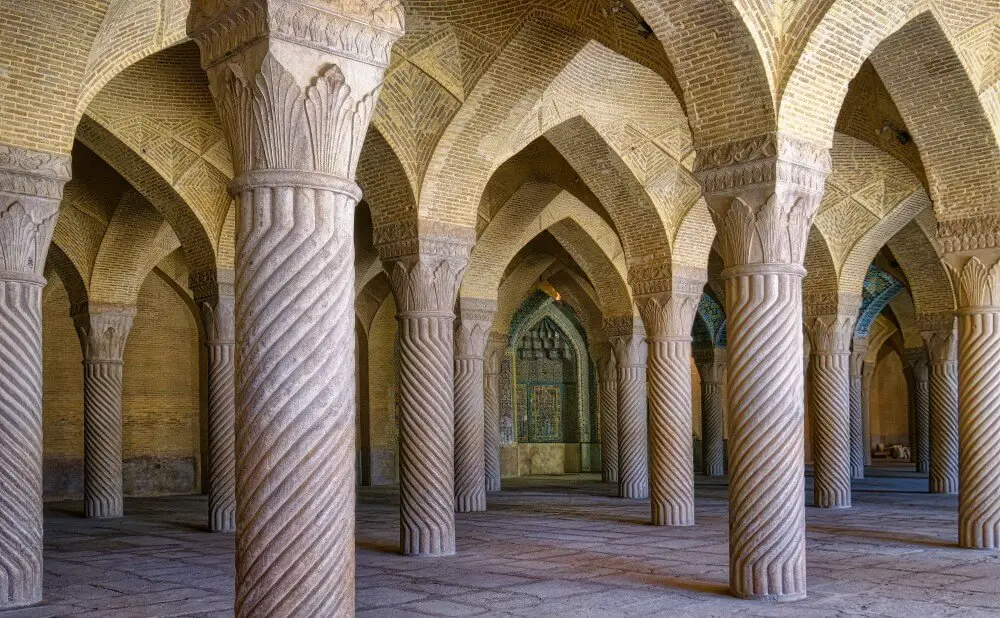A ribbed vault is a common feature of Gothic architecture. Found in constructions of many types, they form part of a roof or ceiling.
Ribbed vaults can be made from a range of different materials, and are usually supported by piers or columns. They are most commonly used in conjunction with other construction elements to create the expansive interiors that are a hallmark of Gothic structures.
This guide will explain all you need to know about ribbed vaults – what they are, how they are used in architecture, and what the difference is between ribbed vaults and some other types of vaults.
What is a ribbed vault in architecture?
A ribbed vault is a type of architectural element consisting of arching ribs that intersect to form a ceiling or roof. Churches, cathedrals, and basilicas are examples of huge, public buildings where you will commonly see ribbed vaults in place. Typically, ribbed vaults are made of stone, brick or concrete depending on the requirements of the project.
The ribs in a ribbed vault are supported by columns or piers, which raise the vaults to a predefined height and support their weight. Smaller ribbed vaults are often decorated with mosaics, frescos or other elements.
When they were first developed, ribbed vaults made it possible for building planners to create rooms with high ceilings and vast interiors. So, many Gothic constructions, such as churches and cathedrals, began utilising them to create a sense of grandeur.
Why are ribbed vaults used in construction?
There are numerous reasons why ribbed vaults are used in building projects. For one, they help to spread weight distribution evenly over a roof span – this makes them ideal for large, cavernous buildings like churches and cathedrals.
Ribbed vaults are also extremely effective structurally. Large, wide spaces can be created without the use of many columns or other supporting structures because they can span considerable distances without the requirement for intermediate supports.
What’s more, they can also offer a decorative feature to a building and are aesthetically pleasant. They are frequently embellished with complex patterns, adding to the grandiosity of the buildings they are featured in.

What are the characteristics of a ribbed vault?
A ribbed vault is characterised by a number of features, including:
- Arched ribs: In a ribbed vault, the ribs are usually arched, which means they are curved to uniformly distribute weight throughout the structure.
- Rigid layer: The arched ribs of a ribbed vault support a thin, rigid layer of stone or another substance. Plaster is a common lightweight material used to create this layer.
- Load-bearing: Ribbed vaults are particularly suited for use in the construction of vast, open spaces like churches, cathedrals, and other public structures – this is because they are made to support heavy loads.
- Large span: vast areas can be created without the use of many columns or other supporting structures thanks to ribbed vaults’ ability to span considerable distances without the need for intermediate supports.
- Decorative features: Ribbed vaults can be used to add a feeling of grandeur and refinement to a building since they are frequently embellished with intricate motifs.
Where are ribbed vaults usually found?
Ribbed vaults are most commonly found in religious buildings such as cathedrals and churches – at the time of their construction, these were often some of the grandest construction projects around. However, you may also find ribbed vaults in other buildings like castles and palaces.
In several countries across Europe, including England, France, Germany, Italy, and Spain, ribbed vaults were quite common during the medieval era. They can also be found in other regions of the world, such as Latin America and several regions of Asia.
Essentially, you can find them anywhere where Gothic architecture had a significant influence.
Famous examples of buildings with ribbed vaults
Around the world, there are a lot of well-known buildings who utilise ribbed vaults as part of their structural framework. Some of the most famous include:
- Salisbury Cathedral, Salisbury, England: ribbed vaults are a significant part of Salisbury Cathedral’s interior, giving it a feeling of opulence and grandeur. Here, they are supported by columns and decorated with intricate carvings.
- Notre Dame Cathedral, Paris, France: one of the iconic features of this Gothic building are the ribbed vaults. They work in conjunction with its flying buttresses to distribute the weight of the roof. When Notre Dame was first constructed, this allowed the insertion of tall, slender windows.
- St. Vitus Cathedral, Prague, Czechia: this Cathedral features distinctive bright-coloured ribbed vaults that give the building an cavernous feel. They have also been adorned with detailed carvings, making them an impressive sight.
- Basilica of San Francesco, Assisi, Italy: the ribbed vaults of this Gothic building are covered with frescoes, as well as some evocative paintings from artists including Cimabue and Giotto. With ribbed vaults like these, the building has maintained a sense of splendour and grandiosity.
- Basilica of Sant’Andrea, Mantua, Italy: this grand Italian church is well-known for its ribbed vaults, which are held up by Corinthian columns. What’s more, they are decorated with frescoes designed by Andrea Mantegna.

What is the difference between a barrel vault and a ribbed vault?
Both a barrel vault and a ribbed vault are architectural features used to support the weight of a ceiling or roof. There are some key differences between the two, however.
On one hand, a barrel vault is a continuous semicircular arch that runs the length of a structure. It is made up of a series of arches that are joined together to form a barrel-like shape. Barrel vaults are known for their strength and stability and are commonly used in long, narrow spaces such as corridors or hallways.
Meanwhile, ribbed vaults use ribs to support the weight of the ceiling. Usually built of stone or brick, the ribs are organised in a pattern to add aesthetic appeal. They are renowned for their capacity to cover vast distances and produce an airiness and spaciousness.
So, the primary distinction between a barrel vault and a ribbed vault is the manner in which they are built and the locations in which they are frequently used. While ribbed vaults are made up of individual arches or ribs and are utilised in big, open spaces, barrel vaults are continuous, semicircular arches that are employed in small spaces.
What is the difference between a groin vault and a ribbed vault?
Despite their similarities, groin and ribbed vaults have different meanings in architecture.
A groin vault is created when two barrel vaults cross each other at an angle. Because of the diagonal lines that are produced where the two vaults come together, they are frequently used for decorative purposes. Groin vaults are renowned for their sturdiness, and are frequently employed in smaller, more private locations, like chapels or tombs.
On the other hand, ribbed vaults are most commonly used in open areas like churches and cathedrals, and are a distinctive aspect of gothic architecture. They are renowned for their capacity to cover vast distances and produce expansive interiors.
To sum up, the primary distinction between a groin vault and a ribbed vault is the way they are used in their respective buildings. While ribbed vaults consist of ribs that expand over large spaces, groin vaults are formed by the intersection of two barrel vaults and are used in smaller areas.
What is the difference between a fan vault and a ribbed vault?
Mainly, the arrangement of the ribs is what distinguishes a fan vault from a ribbed vault. In contrast to ribbed vaults, which have ribs that meet at points of springing, fan vaults have ribs that radiate out from a central point.
A fan vault is a particular kind of vault that uses fan-shaped ribs that spread out. The structure of a fan vault is made up of numerous interlocking arches that are made possible by the radial arrangement of the ribs.
On the other hand, in most cases, ribbed vaults are made of a number of diagonal ribs that cross at locations known as “points of springing,” from which the ribs curve upward. The ribs of a ribbed vault do not extend out from a centre point like those of a fan vault, nor are they organised in a radial manner.
That’s all for our handy guide to ribbed vaults. We hope you agree that they have not only encouraged some of the most famous structures of our times to new heights (quite literally), but they have also played a major part in their grandness themselves.
For more news, guides and discussions from the world of urban construction and architecture, explore more of our articles here.
Or, for similar definitions and full meanings of terms from the building profession, take a look at more of our wikis, including what a flying buttress means!
Last Updated on 29 January 2023 by Michael
